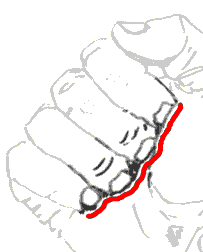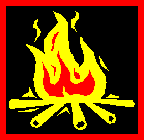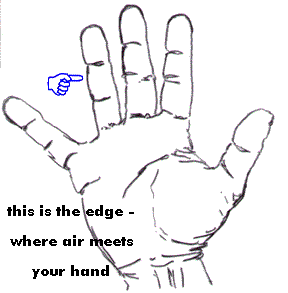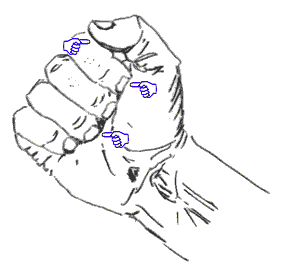The Supply Store
Back to YouCan Draw.Com
Lesson 4: Pure Contour Drawing Introduction |

Review: In the three previous lessons you've done the vase-face exercise, the monster face and the upside-down drawings. In all of these our goal has been, bit by bit, to recognize how it feels to shift in to R-mode. By now, if you've done the exercises, you should be at least a tiny bit familiar with the shift.
Readin',
writin', and
'rithmatic:
getting around your symbol system
When you learned how to read, write and do math, you learned symbols, symbols and more symbols. You learned meanings to words, letters, and numbers. Through time you learned to tie up great amounts of meaning to words. Words like like "basketball player", like "love", or your name, have very specific meanings. By the time you were 10 years old you had an enormous amount of stored experiences, images, and emotions associated to words. Certain charged words like "hate" or "sex" or can trigger whole cascades of internal events, memories, and can even effect body chemistry and physiology.
Words are symbols. The philosophy of language, an absolutely fascinating study of how we arrive at meaning, is concerned with how we make sense out of anything.
A Foreign Language
As you learned to read, write, think in words, or do math, your mind was trained to link all these symbols together. After years of immersion in your native tongue, words carried so much meaning, the word and the experience they evoke become inseparable.
Have you ever gone to a foreign country without knowing the language? It's often difficult to know where one word ends and another begins. Unless you know the syntax and linguistic rules of that language, you're at a loss. Isn't it or wasn't it amazing how a word learned in the new language takes on meaning little by little? If you have to translate from the new language to your native language, the middle step of translating takes a great deal of the impact out of the word or event.
"No pain, no gain"
New words have minimal impact until you've run in to them time and time again - through repeated experiences - until you've integrated and associated the new word to your experience. You learned "hot" and "pain" (or "caliente" and "dolor"- Spanish for hot and pain respectively), as a child after putting your hand on a burner. If you're a native English speaker and you're in the process of learning Spanish, "dolor" or "caliente" just don't have the same impact as the words "pain" or "hot". Unless you really have the word "caliente" thrown in your face while you're burning your hand, the full weight of it's meaning just doesn't get tied to the experience.

(That makes me think of my parents diving for one of my younger brothers or sisters as they tried to keep them from putting their little hands on a red-hot burner screaming "hot, hot!" as they dove.) It's as if you have to learn how to experience from within the new language to feel the full weight of any particular word.
| This is the basis of the study Neuro-Linguistic
Programming (NLP): words and
symbols become so charged with meaning, that just
uttering or hearing the wrong word or seeing a
the wrong gesture can throw you into a panic,
passion, or a blind flurry. For example, just
hearing the word "snake" - with no
snake within a hundred miles - can cause some
people a great deal of anxiety. Becoming aware of
the roots of that association (between the word
or symbol and the emotional experience) allows
you to recognize why you react a certain way when
in certain situations. Knowing what's at the root
of that phobia or - or pleasure for that matter -
allows you to change it's meaning. (Though similar to mainstream psychology, "NLP" is a little more literal in it's approach to changing the meanings of words as a therapeutic measure than mainstream psychology.) |
So the point of this is...
Here's the point: all of these symbol systems - math, language, memory - all have stored meaning. All words, spoken or written, mathematical symbols, visual cues, anything we use more than a couple of times, for economy's sake become abstractions. Through repeated exposure they lose their status as unique experiences and become grouped into composites, into categories, etc. They become a veil or a substitute for direct experience.
As necessary as these skills are in getting us through school, into a job, etc., they block us when it comes to creativity, brainstorming and, in our immediate interest: learning to see. Why? Because when it comes time to draw the particular instance of "white wicker chair with a beagle named Maynard napping on it" (that is if you're going to draw Maynard, an actual beagle, napping in an actual white wicker chair), we instead tend to see the general category of "chair with dog". We fall into abstraction. We miss the detail.
Readin', writin' and 'rithmatic' are all L-mode areas of expertise. What we want to accomplish here is to learn ways to break out of L-modes grip, and get proficient at calling up R-modes greatly underutilized capacities.
In this exercise, we're going to go even deeper into R-mode
Kimon Niccloades, a well known art teacher developed this exercise. in "pure contour". (See The Bookstore). It worked. He thought it worked well because it caused students to use 2 senses: sight and touch. From what's been learned about left and right brain functioning and specialization of tasks, it seems that a more plausible explanation why this works is that this exercise throws you deep into R-mode.
It forces you to minimize or omit any referencing step of figuring, comparing, analyzing, or making logical judgments - things the Left hemisphere of the brain specializes in. When I say "referencing" I'm referring to referencing your memory.
In this exercise your concentration, your present-moment attention, in fact your entire nervous system will be focused on tracking directly any movement your eyes make as they inch along the curves, juts, and direction changes of a line contour, much the same way gravity locks a locomotive onto every turn of it's stainless steel railroad tracks. This kind of focused attention will pull you deep into R-mode. In fact this exercise will probably shift you deeper into R-mode than any exercise thus far. Possibly deeper than any exercise you'll do.
New terms
Edge: In drawing, an edge is where something ends and another thing begins - where two things meet. I'll illustrate. Look at your hand - hold it up in front of your eyes with fingers splayed and palm towards your face. With one eye closed, focus on the outline of your hand. There you are, looking at your hand with nothing but air surrounding it. The edge is where air meets your hand. It forms an outline.

Air meets your hand on all sides forming an edge
Shared edge: Make a fist. Look at where your flexed fingertips are digging into your palm. Look close. As I look at my hand, the tips of my fingers and my fingernails are partly buried in the spongy part of my palm. Two things are coming together: my fingers and my palm.

The pointers show lines demonstrating "shared edges"
The shared edge is that line where the skin of my palm meets my fingertips. I can't see the end of my nail - it's partially obscured by the skin folds of my palm. That resulting line, that margin that's recordable in ink is the shared edge. There's shared edges all over the above illustration. Another one that's pointed out is the line between the thumb and the index finger. When you actually record this "meeting" of two entities, the shared line you observe that is, with a pencil on to your drawing paper, you've created a contour. A contour is...
Contour: You can represent or describe the meeting of two objects or shapes (the shared edge) with a single drawn line - that's called a contour or contour line. A "shared edge" and a "contour" are pretty much the same thing - except, you regard the contour as a single thing.
The difference is conceptual. When you consider a "shared edge", the "shared" part suggests more than one contributor - the edge made between your fingernail and your palm for instance. If you draw nothing else but the shared edge, i.e. draw the actual topography of that margin between your buried fingertip and the spongy part of your palm on a piece of paper, then you have a contour. You flip your attention to just the line formed by the coming together of those two items, and you're now observing a contour. How's that go again?

The contour is in red
You observe the shared edge out there in the real world. When you record what you see on to your paper as a drawn line, you now have a contour. Your eye observes the coming together of two objects. Your hand and pencil draw the contour. The two separate objects disappear since you're attention zooms in to just the shape of that coming together of the two objects, (fingernails and palm for instance). You don't draw all your fingertips because you can't see them all the way to the tips - they're buried in you palm. And you don't draw the whole palm because it's hid by the main body of your fingers or by the angle you're viewing it. Let's isolate the contour:
The isolated contour
I know this gets a little sticky, but it makes more sense when you start talking about drawings. You can pick up the piece of paper with the contour line drawn on it, show it to someone else and they'll say "Interesting line. What the heck is it?" And what is it? It's a contour.
Negative space: is the background. Negative space is often the "nothing" shapes, the non-object shapes that surround the object you're drawing. When you held your hand up in front of your face, it was held against a background of air - the air between your hand and whatever else that was behind it. Paint all that air black, remove the hand, and you have the very next illustration. (You'll be getting a lot more practice with negative space in an upcoming lesson.)
Thinking of the background as the object
Unity: And if you've read right through these definitions, this brings up the idea of unity. All those contour-shaping shared edges are unification's. Those contours represent meeting points of objects and negative spaces. How these all fit together, how their sum creates a composition - that's what unity is all about.
Putting
these new terms to use:
A Warm-up Exercise for Your Brain
To fix it clearly in your head what these terms mean try the following imagination exercise:
You see a sail boat, sailing on a northern lake in the summer time. See the orange triangular sail, sky blue water, gold sun, cottony clouds floating lazily by? Maybe a lone gull in the distance circling the lake.
Freeze the scene in your mind. Imagine each element of the scene as a puzzle piece that's been painstakingly cut out by a jigsaw. "Bob" a piece up and down in your hand. Feel the weight of the wood tapping against your hand as you lightly juggle it. Feel it's it's rounded edges, it's angles, it's curves. Pretend it's a real thing.
(If you're having trouble visualizing, don't feel bad - approximately 3 out of 10 people say they cannot. The good news: you can still learn to draw...and most people can easily learn to visualize. I'll illustrate this below)
Imagine it now as the scene in a child's completed jigsaw puzzle. All the basic elements - the sail, the sun, the water, the trees, the land, all are pieces of the puzzle.
Imagine now the puzzle is disassembled - the way it comes when you dump the pieces out of the cardboard box they came in. All the pieces, the parts of the sky, the evergreens, the sail, the water and the waves have been cut out as separate and complete pieces. They're strewn about on the table in front of you like in the exploded view below:
Now imagine you're piecing it back together. The sky shares an edge with the sail and the sky and the sun, and the water, the sail with the mast, the hull with the water, the water with the horizon. They fit together.
The evergreen tree forms a drawable contour against the orange sail (you could represent it with a diagonal line). The waves share an edge with the boat hull. In fact, the waves in this picture are actually a contour between the boat and the water. The sky around the sun, the tops of the evergreen trees, and down the sides of the picture (suggested by white) is a negative space - complete with a shape of it's own. The blue lake, even though it's an object with a shape of it's own, forms a negative space against the dark blue hull of the boat, the mast and the orange of the sail. Every part of the composition has a job to do: it has unity and so we can make sense out of it.
The Original cartoon
Kasbohm & Company's
YouCanDraw.com
© Copyright, All rights reserved 1997
e-mail: jeffkaz@YouCanDraw
